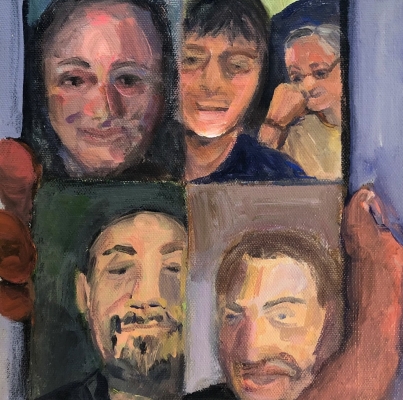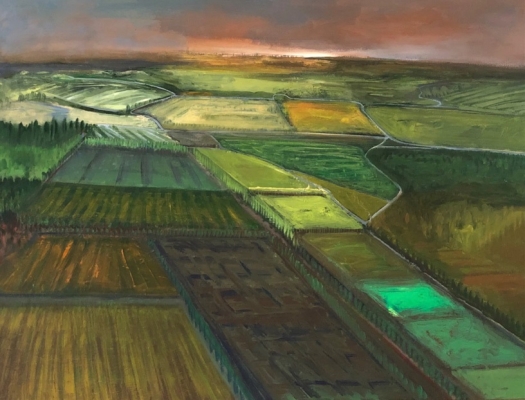Portrait of the Artist
Leah Raab Paints a Diary of Our Lives
We often find ourselves at a loss for words to describe the overwhelming sense of personal and communal dislocation we've experienced in the past few years.
And that's just it. Sometimes words are not enough to communicate the enormity of the experience.
Sometimes you need a painter.
Leah Raab might be described as a photojournalist in paint. And, like the best photojournalists, she doesn't merely record an event. She captures our emotions, infuses each scene with her own feelings, and produces an almost living and breathing chronicle of our times.
"If I see something that moves me, that grabs my attention, even if it's a color or a feeling, I have to record it; it's my way of processing my life," explains the Raanana resident, art instructor at Midreshet Emunah v'Omanut in Jerusalem, and graduate of the Bezalel Academy and New York Studio School.
"Anything that affects me is something I feel compelled to paint."
Notably, Leah's paintings belong to no specific movement or style, as the action and emotion of each moment dictate the style she employs.
A walk through her recent work is a walk through the full corona experience – life in confinement, life outdoors, life in vaccine clinics and life on Zoom.
"This is one of the first ones I did during the lockdown," she explains on our tour of a recent exhibit at Raanana Municipal College. "This man was standing alone outside of his shul, and his tallit had an Israeli flag on it. He was standing alone, really focusing on his prayer. There was an aura around him, and it was so holy. I was in awe.
"It's a mixed neighborhood, but both observant and non-observant came out on Rosh Hashanah," she continued, as we moved along. "It was so beautiful, how everyone came out. Someone in a wheelchair, someone with a baby carriage, everyone came together to listen to the shofar."
Unexpected collisions also appear. One striking scene, not part of the recent exhibit, depicts an early morning minyan vainly trying to shelter itself under the concrete canopy of a public building. Not expecting them there, a provocatively clad young jogger runs into their space. Who was invading whom? The answer is obvious in the flow of her canvases – we were all prisoners indoors and invaders outdoors. This was life lived inside-out.
Public and private are likewise turned on their heads. There are numerous paintings of supposedly private inoculations that are now open to public viewing.
"I didn't know these people," Leah explains. "I didn't know any of the people I painted outdoors or in private moments, except one or two. When you go into a doctor's office, nobody sees you but the doctor. I wanted to have a glimpse into these moments and people agreed to share their vaccination photos with me. People looked very vulnerable and scared, but they still offered their photos for portraits."
Then there were the meetings, family celebrations and largescale Zoom events that we all learned to experience alone on a cell phone. A heartwarming example is a painting of Leah watching her grandson light a Chanukiah on his terrace. She literally holds him in her hand, on her phone, while the glow of the candles lights up a reflection of her son in the terrace window.
Three generations, each reflecting and projecting its own reality. Time and space are redefined.
Life Before Covid
There was a world prior to Covid for all of us, and Leah's was marked by numerous moves between the US and Israel. These, plus the tragedy of her artist-mother's death, are the subjects of her US and Israeli landscapes and her impressionist, expressionist and abstract art.
"Much of my work reflects the paradoxes of everyday life," she says. "What's not always apparent or clearly visible that lurks beneath the surface. It's less about observational painting and more about painting from my heart."
The work speaks volumes about the interplay between art and artist, canvas and life.
"I stopped using oils when my mother died," she says. "My mother died of lung cancer and she believed the toxicity of her supplies led to her illness. I've used acrylics ever since."
There are numerous paintings of lungs, followed chronologically by a series of lung-looking turtles.
"I was traumatized, and I worked through it on canvas," she recounts. "I couldn't stop painting lungs. At the same time, my husband was offered a job in the US, and I felt, 'Where do I belong? What's my home? Do I have two homes?' And that's when the lungs morphed into turtles. It was partly a sign of healing, and partly a realization that the turtle shells are a symbol that my home is wherever I am. The turtles were swimmers."
The reality of life in Israel also crashed into the picture, as it was a time when rocket attacks escalated.
"I related turtle, tsav, to code red, tseva adom," she recalls. "I was studying turtles and I learned that when they're on their backs, they're helpless and exposed. That's how I experienced being bombed. So, I did all these tseva adom paintings of turtles on their backs. It's a little crazy, and maybe I'm too sensitive, but when something affects me so deeply, I have to paint about it."
Locations and Dislocations
Much of Leah's work reflects her time and feelings about a multitude of locations in the US and Israel. Because she often focuses on shape, light and color, not every location is apparent, and city scenes often look different than other artists' treatments of the same place.
Nature and landscapes have a different story.
"When I'm in nature, I'm painting a spiritual experience," she says. "I'm so connected, sometimes it's almost like being in a trance. As though Hashem is doing it with me - these are His creations, nature is His creation, and when I'm painting, I feel Him painting with me."
Art and Life After Covid
"I was extremely limited during Covid," Leah recounts. "I was cooped up. I couldn't visit my kids and I couldn't teach. Art stores were mostly closed, and I couldn't get supplies. There were no galleries for exhibitions. All my work during Covid was done under these conditions."
Yet, in addition to the morning walks that inspired her outdoor series, plus Zoom gatherings and vaccination appointments, she took advantage of this period to create a website featuring her own gallery of work at www.leahraab.com/galleries
Having exhibited previously in both the US and Israel, she hopes to open her portfolio at live exhibitions once again.
As to themes … it remains to be seen how we, and she, experience the post-lockdown world.
To view Leah Raab's work and learn about upcoming exhibits see www.leahraab.com











Comments